- Home
- Ray Bradbury
Listen to the Echoes Page 10
Listen to the Echoes Read online
Page 10
A few days later, Bradbury sat down to write the short story “Olé, Orozco! Siqueiros, Sí!,” a tale about a Los Angeles graffiti artist who dies while hanging from an overpass. The story would go on to be published in the collection The Cat’s Pajamas.
This is how Bradbury works. Art and literature of all kinds influence him. From graffiti to comic strips, fine art, film scores, architecture, literature, and more. No surprise, then, that he has strong opinions on the subject of art and books.
WELLER: You’re passionate about so many different forms of art—from film to fiction, painting to poetry. Is there one art form that you find most moving?
BRADBURY: No. All the art forms are great. You can’t pick one form. Anything that gives you rebirth and makes you want to get out of bed in the morning. Then you’ve got a great art form.
WELLER: You are a film fanatic and a tremendous bibliophile. What do you see as the differences between these two mediums of storytelling?
BRADBURY: David Brown was a producer at Twentieth Century Fox, and he married Helen Gurley Brown, the Cosmopolitan editor. He did a film a few years ago based on Angela’s Ashes, the Irish autobiography. Beautiful film, beautiful book. But you can read a book that’s negative in its aspects—a complete description of Dublin, and the weather and poverty—and not have it kill you because you can pause and close the book. It’s different because when you read it, you’re creating it in your own theater inside your head. But a film is total realism. You can’t change it, it’s right there, there’s nothing you can do about it.
You can change a book in your mind. Every book is like Japanese flowers that go into your head and sink down through the water inside your head and then open out. The difference between books and film is that books are unreality. They open up inside the head. They become yours. They’re more personal. Films are immediate and insistent. They’re like a bully. They bully you with their brilliance, and you can’t turn away from them. Later you may, in remembrance, change them, but it can’t compare to the immediate thing that the book has where the reader fantasizes in the head. After all, it’s only print, it doesn’t mean anything.
You have to learn at a certain age how to read those symbols and turn them into paper flowers that open in the mind. A film makes you think you know everything—you don’t. You can’t escape film. So the long way around to my point, David Brown made this film on Ireland which is beautiful. It’s all about the poverty, and the rain, and the deaths, and when you’re done with the film, you want to kill yourself. I’ll never look at it again. I wrote to him and said, “It’s a beautiful film. I’m glad you made it, but I never want to see it again.”
WELLER: In recent years, you have been quite busy with your own theatrical production company, the Pandemonium Theatre Company. You have arguably given more time to the theater in the last decade than to any other medium. Why do you love the art form of theater so much?
BRADBURY: I love movies, I love poetry, I love novels, but I love theater especially because you get to know the family—all of the actors—from the very beginning, whereas in filmmaking, it’s all fragmentary. You show up at the set, wait for an hour for them to light it, then they do a three-minute sequence, and then they break and set up another segment, another set of lights, and you spend all day waiting! So you don’t get to know people. Another reason I love theater so much is that secretly, I always wanted to be an actor. From the moment when I was three years old and saw The Hunchback of Notre Dame, I loved acting. When I was six, I saw The Phantom of the Opera and that only reinforced my desire to be an actor. In 1939, I joined a theater group run by the actress Laraine Day, and it was there that I realized I can’t remember lines. I’m a good lecturer, but I can’t act.
WELLER: I’d like to talk about some of your literary contemporaries, if you will. What are your opinions of the work of Kurt Vonnegut?
BRADBURY: His writing eludes me somehow.
WELLER: Did you know him?
BRADBURY: We had a wonderful time together in the late 1980s. Yousuf Karsh, the famous photographer, took some pictures of me the same day he photographed Vonnegut. So we had pictures taken together. My first meetings with him, years before that, were not very good. We’re such different people. He was very serious. He lived a serious life. Terrible life, growing up during the bombings of Germany. I don’t know how he survived that. Thousands of people dying all around you. But then the second time with Karsh, we had a lot of fun. He was more relaxed, and Karsh and his wife have terrific senses of humor, so we have great pictures taken laughing together.
WELLER: What are your opinions on the New Journalism of the 1960s?
BRADBURY: Some of it is very good. Slouching Towards Bethlehem by Joan Didion is wonderful. And I love From Bauhaus to Our House by Tom Wolfe. Truman Capote’s early work I like very much, his short stories, of course. A Christmas Memory is beautiful.
WELLER: What about In Cold Blood?
BRADBURY: I didn’t care for that. He got involved with those criminals while writing that book. I don’t believe in reality. He was kidding himself about a new style. I don’t believe he invented a new style. Capote was a clerk at Mademoiselle magazine in 1945 before he became well known, and he was helping the fiction editor, Rita Smith, look over the slush pile of short stories that came in the mail to the magazine. I sent a short story to them that Weird Tales had rejected because it wasn’t their cup of tea. They wanted a traditional ghost story. I had run my course at Weird Tales. I’d sold one story to Mademoiselle at that point, and I sent my vampire story, “Homecoming.” This story was in the slush pile Truman Capote was helping read through. He turned to Rita Smith and said, “Hey, look at this story here. You ought to buy this.” And he gave her a copy of “Homecoming.”
They held it for many months not knowing what to do with it—it was so unusual for the magazine. They finally sent me a telegram that said, “We were thinking of ways to change your story to fit the magazine, and then we decided to change the magazine to fit the story.” So they bought it, and it appeared in a special Halloween issue of Mademoiselle, beautiful. They got Charles Addams to illustrate the story, and they invited me back to New York to meet all the editors. And so, on Labor Day weekend, 1946, I went on a train to New York and the Mademoiselle people put on a big party for me—Mr. Davis, the head editor, as well as Rita Smith, who was Carson McCullers’ sister. I went to this party and Charles Addams was there, Carson McCullers and her husband—it was incredible. I was accepted into New York intellectual society at the age of twenty-six.
I had lunch with Charles Addams, and I told him how much I loved his illustrations, and we planned on doing a book together about his family and my family. We both had the same idea at the same time, but his family was spookier than mine. Mine was much more human. So we corresponded about that. We submitted ideas to various publishers together and nothing ever happened. Along the way, later that year, I bought the painting he did for “The Homecoming” in Mademoiselle from him for, God knows, around three hundred dollars, which I didn’t have, so I paid for it on time, maybe thirty dollars a month. But thank God I bought it and kept it all these years.
WELLER: And Truman Capote was responsible for the sale of that story? Did you ever meet him?
BRADBURY: I saw Capote. I had the chance to thank him. At the Hotel Bel-Air one day about twenty-five years ago, while visiting with my agent, I looked across the pool and there was Truman Capote sitting there. I went over and introduced myself and said, “Mr. Capote, I owe you a lot of thanks.” He said, “For what?” “Well,” I said, “you were in Rita Smith’s office thirty years ago, and you got her to buy my short story,” and he remembered. So I was able to shake hands with him and thank him.
WELLER: While we are on the topic of the founders of the New Journalism movement, what are your opinions of Norman Mailer?
BRADBURY: He didn’t like life. He was a typical male. The secret of males is this: We are jealous of women. They have all the power. The
essence of a woman is the power she has to attract just by being. A lot of men beat the hell out of their women because the women are too powerful. They hate that. So Norman Mailer never liked life, he didn’t like women, they were too powerful, he beat up on his wives, he stabbed one, so I didn’t like Norman Mailer because his books were full of this need for masculine power. I don’t believe in masculine power. I’m not masculine. I’m a sissy. I’m a reformed sissy, because when I met and married Maggie she helped me grow up. She helped me stop being a sissy, and in the process I became a good writer. But it’s not masculine junk.
WELLER: Did you ever meet Mailer?
BRADBURY: My good friend Sid Stebel and I met him at the Beverly Wilshire Hotel the night they had a publication party for his book about Marilyn Monroe. That was around 1973. John Huston was there because he liked Mailer. And Mailer came into the room and I ran over and said, “Mr. Mailer, my name is Ray Bradbury, and my friend and I have read your book,” and he sailed on. That was it. He escaped me. He didn’t want to know who I was. So I never had the chance to talk to him. So what the hell.
WELLER: Do you know Gore Vidal?
BRADBURY: A very nice man. When I was in New York in the early 1950s I met him, and we walked all across the city and talked about writing and books.
WELLER: Completely changing subjects, what do you think of the Harry Potter books? They were banned by some school boards across the country.
BRADBURY: I bought all of them for my grandchildren. They’re wonderful. That series is like Something Wicked This Way Comes. Listen, if they are offending some people, it’ll all blow over. I tell the teachers and the librarians when they contact me, “Look, when the people come into the library to remove a book from the shelf, when they’re gone, put it back on the shelf.” If they come back a week later, say, “Oh! What’s that book doing on the shelf? Gee, how did it get there?” If they take the book again, when they are gone, put it back. They’re going to lose eventually. We’ve never had censorship in this country. No book burnings, nothing major.
WELLER: You really believe we’ve never had censorship in the United States?
BRADBURY: Like I said, nothing major. It seems to go in cycles. If it gets bad, it eventually blows over because people get upset.
WELLER: You were an avid reader of comic strips when you were a child. Are you still a fan of the more contemporary strips?
BRADBURY: Oh, yeah. I love Mutts, that’s my favorite. The Wizard of Id, and B.C., and of course when the Peanuts were still being reprinted. Calvin and Hobbes is great.
WELLER: Were you a fan of superhero comics as a child?
BRADBURY: Not really. They didn’t appear until I was nineteen. Well, they’re boring, anyway. They’re too strong, you see. Tarzan is vulnerable. Occasionally he almost gets killed, and it takes him months to recover.
WELLER: How about the character of Batman, then? He had no powers. He’s vulnerable.
BRADBURY: That was too late. I was nineteen or twenty. They’re all too fantastic, you see. They did impossible things like flying through the air. I like Tarzan because he did something I knew about; he could climb trees, or swing on vines.
WELLER: But the Mars stories of Burroughs are impossible, and they had a huge influence on you.
BRADBURY: Well, Mars is different. John Carter is all fantasy. And I accepted that. But it wasn’t impossible fantasy—it was based in swordsmanship.
WELLER: Did you and your wife have the same literary tastes?
BRADBURY: Different. She liked Henry James more than I do. I prefer short things, short novels. And she liked to read a lot of history. She knew everything there was to know about French history, French writers, Camus and Proust. She was very fluent in the French language. When we traveled through France, they thought she was French. She read all the time. And she loved mysteries. She read everything by Agatha Christie.
WELLER: Architecture has always been very near and dear to your heart. Over the years, you have worked as a design consultant in a number of high-profile projects, including scripting the interior concepts for “Spaceship Earth” at Disney’s EPCOT Center. How did you first get involved with architecture and design?
BRADBURY: It started with the United States Pavilion at the 1964 World’s Fair. Two men showed up at my door in 1962, and they were from the United States government representing the World’s Fair, which was building in Flushing Meadows in New York. I asked them what they were doing at my door, and they said, “We’ve come to offer you a fifty-million-dollar building,” and I said, “Come in! Come in!” They had read my essay “The Ardent Blasphemers” from the Bantam edition of 20,000 Leagues Under the Sea about Captain Nemo and Captain Ahab, the madness of both men and the inherent blasphemy of the American spirit. They read this essay of mine, and they said, “We think you are the very man to create the top floor of the United States Pavilion.”
WELLER: When did you discover your passion for architecture?
BRADBURY: When I was eight years old. I saw the covers of science fiction magazines with the fabulous paintings of the cities of the future. And then when I was thirteen years old I went to the Chicago World’s Fair and walked among the cities of the future, with all of the wonderful colors and shapes and sizes. When it came time to go home that night at the fair, I didn’t want to leave. My mother and father had to drag me out of the fair. They were taking me away from the buildings of the future. So I went home and I started to build those buildings in the backyard—very dreadful cardboard cutouts, but I began to make outlines for cities of the future when I was fourteen. And I began to write, because I discovered a remarkable and terrible thing about the Chicago World’s Fair. After two years, they were going to tear most of it down, and I thought, “How stupid,” not to leave the future up and build toward it. So, since they were going to tear down the future, I began to write about it when I was thirteen, and fourteen.
WELLER: You have done design work on shopping centers in Southern California. How did that come about?
BRADBURY: Over a period of time, living in Los Angeles, I became disillusioned with what I saw going on in Hollywood. Hollywood for many years was like Hiroshima at high noon. Downtown LA has gone to hell for quite a while. So in 1970, I wrote an article for the Los Angeles Times about what we should do with downtown LA and I made a sketch of the perfect plaza and what we should put into that plaza.
A couple of years later, Jon Jerde, who was a budding architect, came to me and we had lunch. During lunch he said to me, “Have you seen the Glendale Galleria?” I said, “Yes, I have.” “What do you think of it?” And I said, “I think it is quite wonderful.” He said, “That’s yours. That’s the article you wrote in the Los Angeles Times, and I followed your directions and I built the Glendale Galleria.” I said, “Am I allowed to say that?” And he said, “Yes, of course, why?” And I told him, “Because I want to claim that you are my bastard son!” So I joined Jon Jerde’s firm in an amateur capacity for the next year or so. We were like kids playing in a sandbox. We threw ideas up in the air like confetti and ran under them. During this time, we made plans for Horton Plaza down in San Diego, and it was the most fun I’ve ever had in my entire life.
WELLER: Do you have a favorite building or structure?
BRADBURY: The Chrysler Building in New York. It’s as beautiful as a Russian Easter egg. And to think, some people made fun of it when it was first built. It didn’t look like all the boxes in New York City. I first saw it in 1939, and I loved it. Later, my agent, Don Congdon, had an office right next to it, and he had a view right from his office window of the Chrysler Building, which was just two blocks away. It was right there, through the window, and it was magnificent.
WELLER: Any others?
BRADBURY: So many. I love the Marin Civic Center in Marin County, California. That building is a treasure. It’s surrounded by nothing and with its wonderful blue roof it’s as if a piece of porcelain sky had been ripped out of the heavens and fired in an oven and mad
e even more blue and fantastic. So when you see this jewel lying there, this gigantic piece of blue sky lying there on the ground covering that beautiful architecture, it’s simply impossible. I also love Rockefeller Center. The way it closes in on the crowds that go there, and then you have the restaurant mall in the center, and then you have Apollo, that great golden statue, hovering over all of it—it’s a terrific combination of modern architecture planning and mythology. Outdoor plazas are so much more fun than enclosed areas. You can breathe better, the air gets to you, and, as I said somewhere in Dandelion Wine, eating a sandwich, sitting on the grass, smelling the air—the sandwich tastes better.
WELLER: What contemporary architects do you admire?
BRADBURY: Santiago Calatrava is a genius. His work is beautiful.
WELLER: Switching mediums, I know that you are a fan of film scores. Who, in your mind, are the great film composers?
BRADBURY: Bernard Herrmann, of course. And Erich Wolfgang Korngold. He did the score for Robin Hood and The Sea Hawk, and two or three other films. They did a symphonic night of his music a few years ago in Los Angeles, and I went down to hear it. His music was incredible. I wish I could have met him so I could have hugged him.
WELLER: Who are your favorite painters?
BRADBURY: The whole Wyeth family. N.C. Wyeth, the father, who illustrated children’s books, like Treasure Island. His son, Andrew Wyeth, became famous, as did N.C. Wyeth’s daughter, Henriette. All the Wyeths were inspiring to me because they inspired one another. They had a showing of Andrew Wyeth’s work at the Art Institute in Chicago once and I could hardly get in, the line was so long. It was beautiful. Goya is also marvelous. I used his work on the covers of two of my books, and nine of his illustrations were used inside a special edition of October Country. His work is mysterious and evocative.
WELLER: How about the Impressionists?

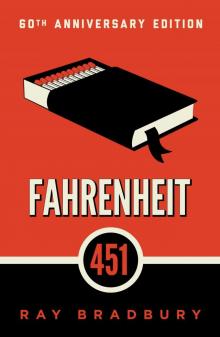 Fahrenheit 451
Fahrenheit 451 Zen in the Art of Writing
Zen in the Art of Writing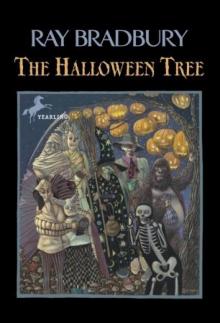 The Halloween Tree
The Halloween Tree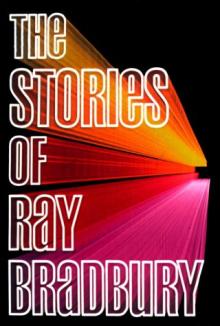 The Stories of Ray Bradbury
The Stories of Ray Bradbury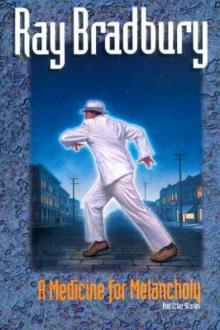 A Medicine for Melancholy and Other Stories
A Medicine for Melancholy and Other Stories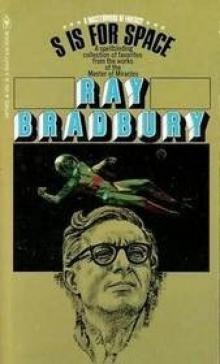 S Is for Space
S Is for Space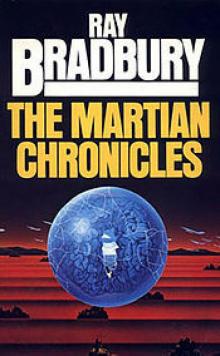 The Martian Chronicles
The Martian Chronicles Futuria Fantasia, Winter 1940
Futuria Fantasia, Winter 1940 Farewell Summer
Farewell Summer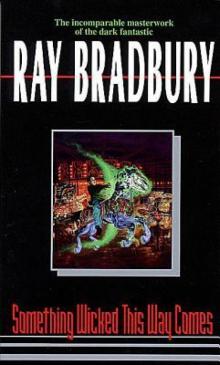 Something Wicked This Way Comes
Something Wicked This Way Comes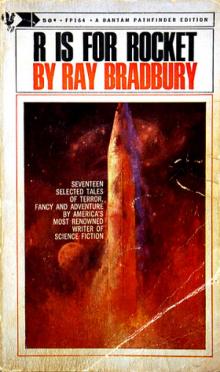 R Is for Rocket
R Is for Rocket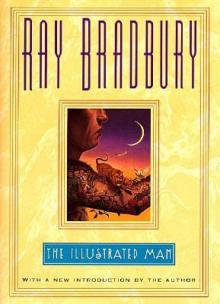 The Illustrated Man
The Illustrated Man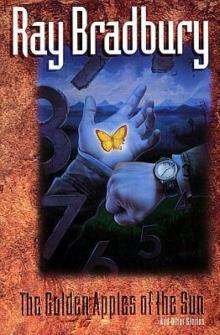 The Golden Apples of the Sun
The Golden Apples of the Sun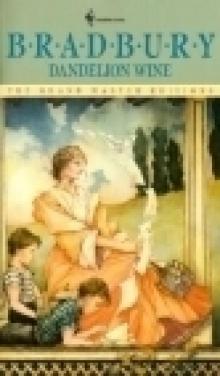 Dandelion Wine
Dandelion Wine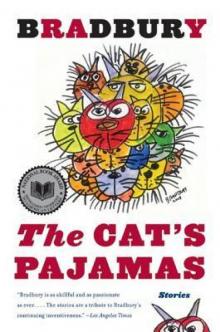 The Cat's Pajamas
The Cat's Pajamas A Graveyard for Lunatics
A Graveyard for Lunatics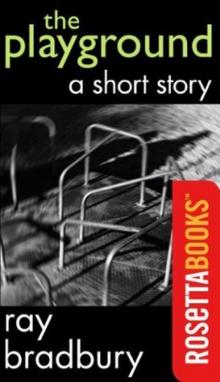 The Playground
The Playground We'll Always Have Paris: Stories
We'll Always Have Paris: Stories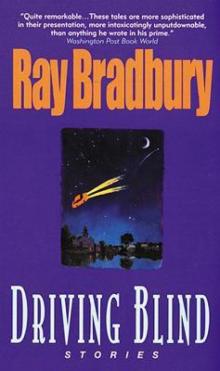 Driving Blind
Driving Blind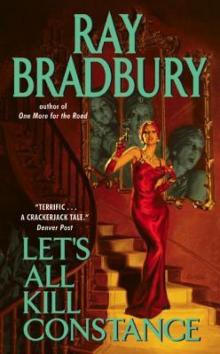 Let's All Kill Constance
Let's All Kill Constance The Day It Rained Forever
The Day It Rained Forever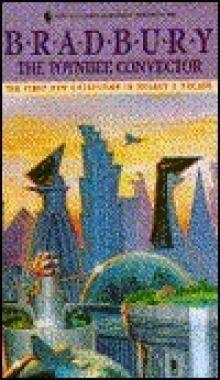 The Toynbee Convector
The Toynbee Convector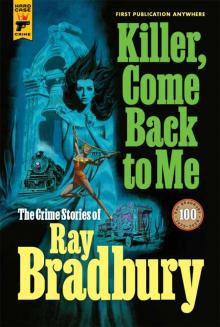 Killer, Come Back to Me
Killer, Come Back to Me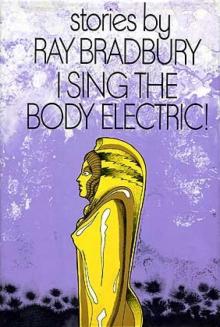 I Sing the Body Electric
I Sing the Body Electric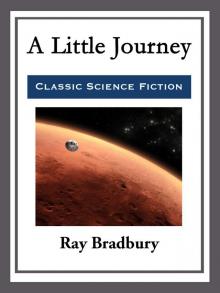 A Little Journey
A Little Journey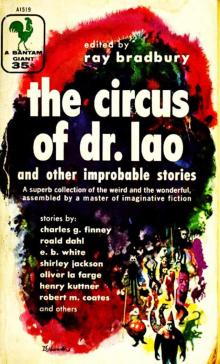 The Circus of Dr Lao and Other Improbable Stories
The Circus of Dr Lao and Other Improbable Stories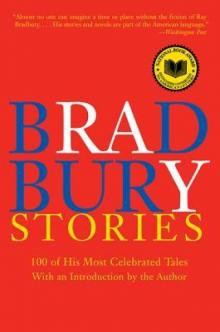 Bradbury Stories: 100 of His Most Celebrated Tales
Bradbury Stories: 100 of His Most Celebrated Tales From the Dust Returned
From the Dust Returned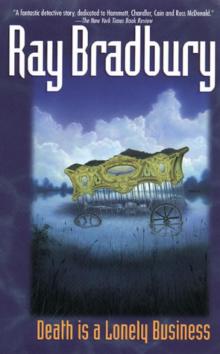 Death Is a Lonely Business
Death Is a Lonely Business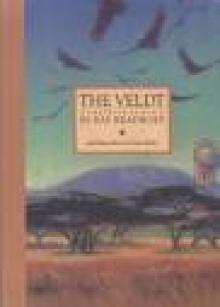 THE VELDT
THE VELDT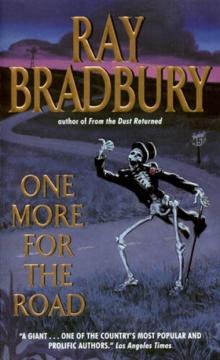 One More for the Road
One More for the Road Futuria Fantasia, Summer 1939
Futuria Fantasia, Summer 1939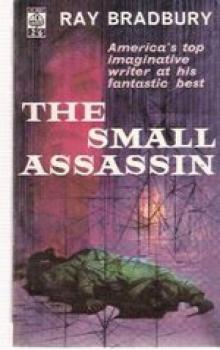 The Small Assassin
The Small Assassin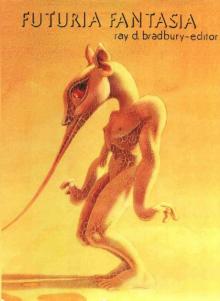 Futuria Fantasia, Fall 1939
Futuria Fantasia, Fall 1939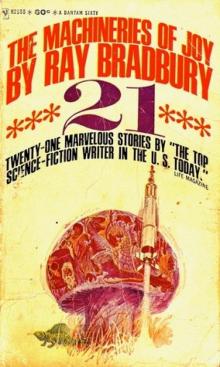 Machineries of Joy
Machineries of Joy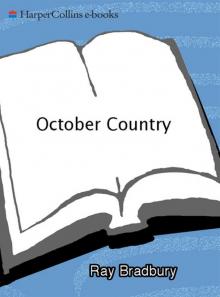 The October Country
The October Country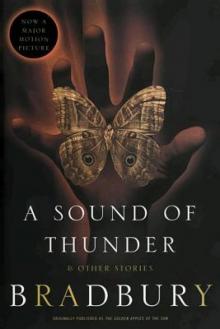 A Sound of Thunder and Other Stories
A Sound of Thunder and Other Stories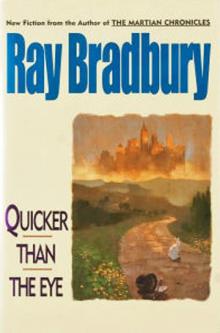 Quicker Than the Eye
Quicker Than the Eye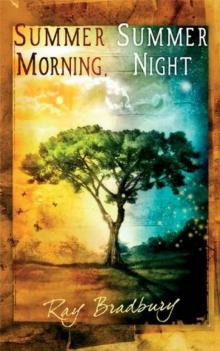 Summer Morning, Summer Night
Summer Morning, Summer Night Yestermorrow
Yestermorrow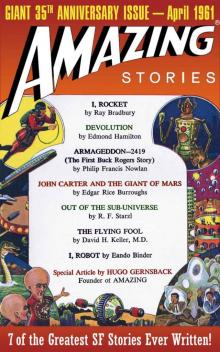 Amazing Stories: Giant 35th Anniversary Issue (Amazing Stories Classics)
Amazing Stories: Giant 35th Anniversary Issue (Amazing Stories Classics)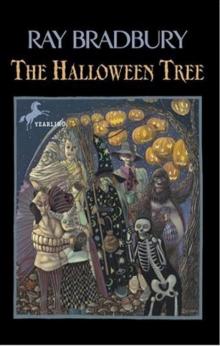 (1972) The Halloween Tree
(1972) The Halloween Tree Listen to the Echoes
Listen to the Echoes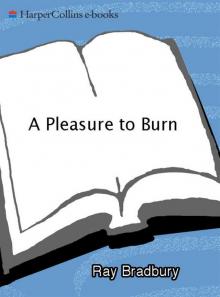 A Pleasure to Burn
A Pleasure to Burn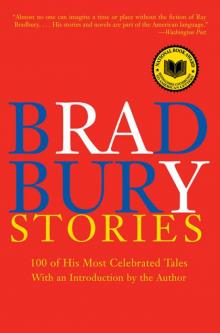 Bradbury Stories
Bradbury Stories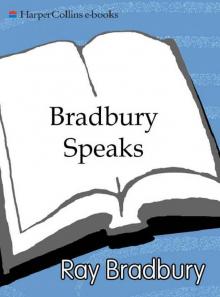 Bradbury Speaks
Bradbury Speaks Ray Bradbury Stories Volume 2
Ray Bradbury Stories Volume 2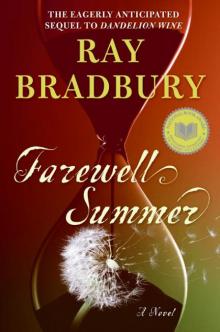 Farewell Summer gt-2
Farewell Summer gt-2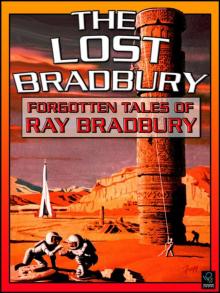 The Lost Bradbury
The Lost Bradbury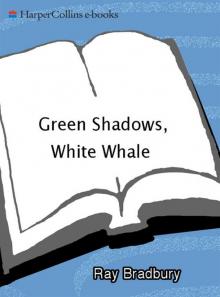 Green Shadows, White Whale
Green Shadows, White Whale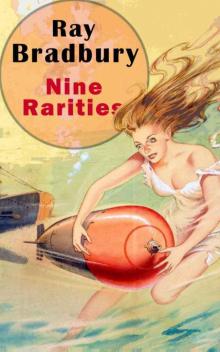 Nine Rarities
Nine Rarities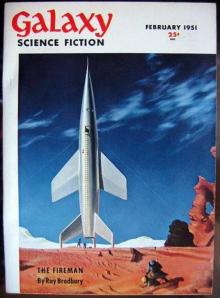 The Fireman
The Fireman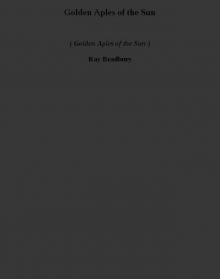 Golden Aples of the Sun (golden aples of the sun)
Golden Aples of the Sun (golden aples of the sun)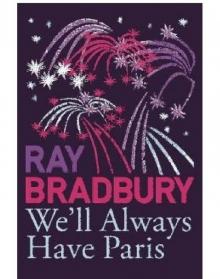 We'll Always Have Paris
We'll Always Have Paris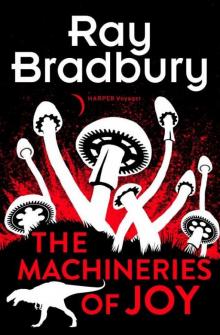 The Machineries of Joy
The Machineries of Joy A Graveyard for Lunatics cm-2
A Graveyard for Lunatics cm-2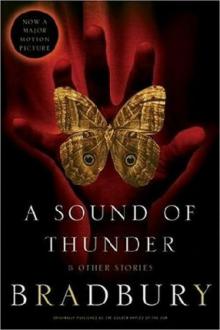 The Sound of Thunder
The Sound of Thunder Where Robot Mice and Robot Men Run Round In Robot Towns
Where Robot Mice and Robot Men Run Round In Robot Towns